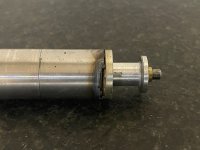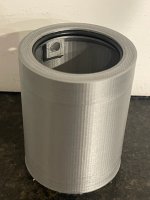I cranked up the cc knob on the boost controller and got it to feed 10 amps to charge my battery. But it quickly wattage dropped quickly because my battery was already charged. Seems to be working well.
I was just set up to do a healthy set of bench runs with temperature measurements to wear my battery out and test the charging system before installing into my car.
But….. on my first run, my pressure was looking great at first to motor levels but did not climb to 6 PSI as it should have and the amp draw was too high (200 vs expected 180 AMPS). And then the smell…. The smell of failure.
Another one (rotor) bites the dust!
View attachment 710
What causes this kind of mode of failure? It seems like it was arcing at the end of the rotor.
So, I see 3 possible paths forward.
1A) I just have bad parts, there was again a ton of balancing compound on the shaft end. Replace with like in kind but better balanced and perhaps fabricate a shrink to fit shaft.
1B) I have bad parts… move to TP motor? Or really step up to German motor? This could require refabrication of extension shaft, back panel. Or best case scenario just adjust spacer thickness.
2) I have a design issue. Honestly, it was running very smoothly, but maybe could move away from the set screw approach and go for the shrink on shaft extension like matnrach with a shorter extension shaft.
3) abandon direct drive? I know that WB has had similar issues to me with a similar approach but using the TP motor. I think he is still waiting on a new ESC
4) abandon project? This would be a shame, since the rest of the system seems so solid. So hoping to find a way forward.





